Marvel/Sunbow Productions (September 12, 1983 – October 1, 1985), Shout! Factory (July 14, 2009), 4 discs, 480 mins plus supplements, 1.33:1 aspect ratio, Dolby Digital 2.0, Not Rated, Retail: $29.99
Storyboard:
G.I. Joe is the code name for America’s daring, highly-trained, Special Mission force. Its purpose: To defend human freedom against Cobra, a ruthless terrorist organization determined to rule the world.
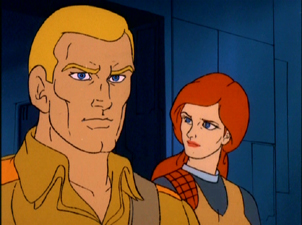
The Sweatbox Review:
G.I. Joe is the quintessential specimen of American television of the 1980s. It was a time of Reagan, the Iron Curtain, and the resurgence of American patriotism that had been battered by the Vietnam War of the 1970s. By the 1980s, Americans were ready to be proud of their military again and were clamoring for new heroes. The stock market was on the rise, and the Soviet Union seemed to be in decline after failing in Afghanistan. The show had almost everything that was typical of the period: the clear-cut good and bad guys, the patriotism from the later part of the Cold War, and an action-packed story that was repeated every week. Each episode featured an elite force of the American Military called G.I. Joe defeating terrorists of the Cobra organization. Cobra would usually begin with the upper hand after demonstrating one of their latest weapons of mass destruction. G.I. Joe would then spend the rest of the episode chasing after the terrorist leaders and dismantling the weapon. Victory was all but assured at the end of each episode and the popular show became a hit with children of the 80s.
Part of what made this toy-turned-cartoon such a success in the 80s is the marketing effort behind the release of the show. Hasbro originally licensed the toy line in the 60s and re-launched the action figures in 1982 complete with a storyline created to increase interest in the different characters. The toys were an immediate success and it was an experiment that Hasbro would continue throughout the 80s. Whenever they released a new toy line, they would make sure that consumers understood the stories behind the toys. Two years later, when Hasbro came up with the marketing strategy for their line of robots that can transform into cars (The Transformers), they decided to release a comic book and cartoon parallel to the sale of the toys. When that cartoon became a hit, Hasbro went back to G.I. Joe and decided to partner up again with Marvel and Sunbow Productions (the makers behind The Transformers) with a five-part miniseries based on the toys.

G.I. Joe started with a series of annual five-part miniseries, each introducing new characters as part of the marketing effort behind the toys. Ron Friedman, the writer best known for his work on sitcoms such as Chico and the Man and Fantasy Island, was commissioned to write the episodes as if they were live-action films. He was handed the task of fleshing out the different characters of the G.I. Joe team and Cobra. On the G.I. Joe side, the team was led by Scarlett and Duke (and alternatively Flint) and featured memorable characters like Lady Jaye, Shipwreck, and Snake Eyes. Of course, for me, the best characters were the villains. No one is funnier and more diabolically comical than Cobra Commander – a character whose face is never revealed and who frequently gets frustrated by G.I. Joe. Somehow, he leads a group of henchmen most notably made up of Destro, his right hand man, and Baroness, the sole female villain. Cobra is also sometimes allied with Zartan and his gang of mercenaries, and the twins Tomax and Xamot. Many of these characters were introduced in the comic books and were so popular they subsequently made their way into the animated show.
Between 1983 and 1985, G.I. Joe gradually developed from a one-time miniseries to a full-fledged animated series. The show was introduced to audiences with three miniseries, each premiering a year apart. The first miniseries, G.I. Joe: A Real American Hero, premiered on September 12, 1983 and was followed a year later by a second miniseries, G.I. Joe: The Revenge of Cobra, in September 10, 1984. The two miniseries were almost mirror images of one another with Cobra getting hold of a threatening weapon, G.I. Joe attempting to dismantle the weapon, Duke being captured, and Destro getting away in the end. The third miniseries, G.I. Joe: The Pyramid of Darkness, acted as the premiere for the show’s first season when it premiered on September 16, 1985. The first stand-alone episodes of the show premiered immediately after the third miniseries.
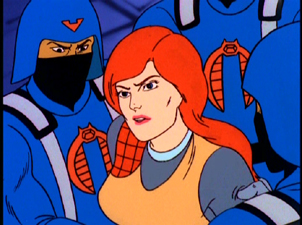
G.I. Joe: A Real American Hero (also known as The MASS Device), begins with the episode “The Cobra Strikes” where we learn that Cobra has developed a weapon called the M.A.S.S. Device. The weapon, more of a powerful teleporting machine, is used by Cobra to steal a military satellite and G.I. Joe is called to save the day. In episode two, “Slaves of The Cobra Master” , we learn that COBRA has enslaved a group of people with a mind controlling device and they force Duke to fight for his life in a match to the death. In the third episode, “The Worms of Death” , the G.I. Joe team begins to compile the resources to create their own M.A.S.S. device and face head-to-head battles with Cobra in the bottom of the ocean and in an Arctic cave. The final element needed for the device pits the team against Cobra at the edge of an active volcano in the fourth episode, “Duel In The Devil’s Cauldron” . It all culminates in the final episode, “A Stake In The Serpent’s Heart” where the two groups face-off at their headquarters on Cobra Mountain. As a first miniseries and introduction to the G.I. Joe world, the five episodes serve their function. While not necessarily leaving room for a sequel, the show does a good job at showcasing characters such as Snake Eyes, Cobra Commander, Duke, and Scarlett. My main problem with the miniseries is that the villains seem very distracted at times from their main task and the whole slave subplot is never really addressed (Who are these people? Where do they come from?). Actually, there is very little back story to most of the characters and viewers are more or less thrust into the action in the very first episode with little explanation. However, the story is mostly engaging and easy to follow.
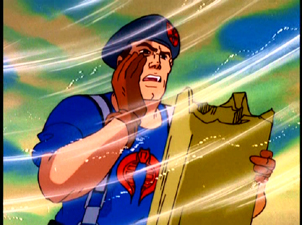
The second miniseries, G.I. Joe: The Revenge of Cobra, returns with some of the characters featuring design changes (most notably Snake Eyes and Cobra Commander). In the first episode, “In The Cobra’s Pit” , Cobra captures Duke and Snake Eyes while battling to capture a powerful laser. With the laser, they are able to build and complete the “Weather Dominator”, a weapon that can control the weather (think Global Warming being used as a weapon). In the second episode, “The Vines of Evil” , Cobra begins an attack on Washington, DC, but when G.I. mounts a defense, the weapon splits into three parts scattered all over the globe. In the last three episodes of the miniseries, “The Palace of Doom” , “The Roof of the World” , and “Amusement Park of Terror” , the Joes travel to different locations to recapture the fragments, culminating in the final battle at Cobra’s Temple. The miniseries introduces several new characters including Zartan and his gang of mercenaries (who oddly enough sound like Aussie Cajuns to me), Shipwreck (who is introduced as a mercenary but becomes a standard G.I. Joe member by the third miniseries), the wise Native American fighter Spirit, and his Cobra counterpart the ninja Storm Shadow. The story is very similar to the premiere miniseries with many elements only slightly altered. Both stories rely on an all-powerful weapon of mass destruction misused by Cobra and on the subsequent battle to control the components spread out across the world. Even the locations do not seem to vary, and we get an Arctic location in both stories, most likely to highlight the different specialties of each character/toy.

The third miniseries, G.I. Joe: The Pyramid of Darkness, once again pits the G.I. Joe team against a superweapon controlled by Cobra. This time, Cobra is not only aided by Zartan and his gang, but also by the twin duo of Tomax and Xamot. In this miniseries, the threat comes from outer space when Cobra gains control of the Moon Star space shuttle in the first episode, “The Further Adventures of G.I. Joe.” From space, Cobra links up to special cubes scattered in four strategic locations creating a pyramid that disables machines and vehicles. In the second episode, “Rendezvous In The City of the Dead” , G.I. Joe attempts to thwart the activation of three of the four cubes (I don’t understand this particular plot point, but I roll with it). In the third episode, “Three Cubes to Darkness” , Cobra moves to activate the fourth and final cube while Xamot plans to save his twin brother who was captured by G.I. Joe. The battle culminates in “Chaos in the Sea of Lost Souls” , once again set in the Arctic. Cobra’s organization begins to crumble in “Knotting Cobra’s Coils” as the struggle develops between rival factions within the organization. Once again, the final battle happens at the Cobra Temple where the Joes once again try to destroy Cobra. While I understand that these three miniseries were broadcast nearly a year apart from one another, the repetition and lack of creativity in the show begins to show. The few variations are in some of the location of the devices/weapons, the G.I. Joe teams, and some of the different subplots. Overall, this is not the best premiere for the show, but mainly for lack of originality which would not be a factor if I had watched this a full year after the previous episode.

The first stand-alone episode for G.I. Joe was “Countdown for Zartan” where Zartan infiltrates the Worldwide Defense Center (part CIA, part NATO) and plants a bomb. In the episode, the Joes must fight against the clock to find the bomb and defuse it in time. The episode, written by Christy Marx (best known for her future work on the show Jem), features some great examples of comic timing and suspense as we know the clock is ticking away to the finale. In “Red Rocket’s Glare” , Cobra, under the guise of the Red Rocket restaurant chain, places powerful rockets in locations across the country. The episode highlights the character Roadblock as his parents own one of the restaurants. In the third stand-alone episode, “Satellite Down” the Joes attempt to recover a satellite knocked-down by Cobra, and find themselves in a three-way battle for the device. “Cobra Stops the World” features a scheme by Cobra to control the world’s oil supply (writer Steve Gerber was apparently inspired by his work on The Transformers). In “Jungle Trap” (written by Paul Dini of Batman:TAS fame), Cobra creates a new weapon that can control the energy of the Earth’s core and the Joe team must come to the rescue. In “Cobra’s Creatures” , they create a device that can control the Earth’s animals and even the Joe’s own Junkyard (Snake Eye’s dog) turns against them. Finally, the last episode on the set is “The Funhouse” and it features the Joes fighting their way into the Cobra Temple to save some kidnapped scientists (another recurring theme in the G.I. Joe world).
Is This Thing Loaded?

Shout! has put together a great release for fans with many bonus features not found in previous G.I. Joe releases. Each of the first three discs feature an interview with writer Ron Friedman who wrote the miniseries contained in those discs. These interviews are called ”Looking Back With Writer Ron Friedman”, Part One, Two, and Three (7:01, 7:03, and 4:44, respectively). In these interviews, Friedman is visibly proud of his achievements and discusses his initial contact with the show and his idea behind the miniseries. He talks a lot about character development and how Hasbro wanted to showcase different characters throughout the show. While individually short, the total interview time across the three discs really does allow fans an opportunity to get to know Friedman and his story.

The fourth disc features the bulk of the special features. Of these, perhaps the ones fans are most excited to see are the “Knowing is Half the Battle PSAs”. These public service announcements were played at the end of each G.I. Joe episode and were meant to highlight child safety concerns. Each segment, approximately 30 seconds in length, featured a G.I. Joe teaching a child about what they should do in a certain dangerous situation (or how to avoid them). These were endorsed by the National Child Safety Council and the fact that adults today still remember them is a testament to their enduring character. The disc features seven PSAs (total of 3:42): Alpine – What To Do When You’re Lost, Barbeque – What To Do If Your House Is On Fire, Deep Six – Don’t Swim When It’s Storming, Mutt – Don’t Pet Strange Dogs, Quick Kick – Take Your Time When Building Your Tree House, Spirit – What To Do If You Catch On Fire, and Torpedo – How To Tread Water.
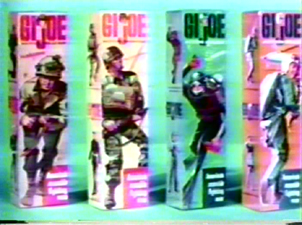
While the PSAs are very memorable, the most exciting bonus feature on the fourth disc is ”G.I. Joe’s Original 1963 Toy Fair Presentation” (9:06). In this promotional ad aimed at the retail market, introduces the toys for the first time and announces the different products that were going to become available. It features a narrator discussing the marketing strategy, the research behind it, and an explanation of the entire toyline. On the screen, we see a boy playing with the different toys and we also get to see some war footage. It is interesting to me because it gives us a glimpse behind the strategy of the original toy. In essence, the 80s show was an extension of the same marketing strategy that started way back in 1963.
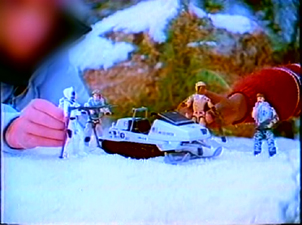
Rounding up the set are three Archival Hasbro Toy Commercials from the 1980s. These are approximately 30 seconds each with a total running time of 1:31. The commercials are titled “Collection”, “Breaker & The Rapid Fire Motorcycle”, and “Polar Battle Bear.” Finally, a printable “Jungle Trap” PDF script is included in the DVD-ROM portion of the disc. The 48 page script written by Paul Dini includes handwritten notes with revisions suggested by Hasbro and the show runners. The notes provide valuable insight into the way the show was produced.
Case Study:
G.I. Joe: Season 1.1 is being released as a four-disc set. This release is in line with Shout! Factory’s previous Transformers release. The four discs are divided into two slim cases, each holding two discs. The discs are housed on either side of the case. The first disc contains the five episodes for G.I. Joe: A Real American Hero along with one Ron Friedman interview. The second disc contains the five episodes for G.I. Joe: The Revenge of Cobra along with another Ron Friedman interview. The third disc contains the five episodes for the third miniseries, G.I. Joe: The Pyramid of Darkness along with the final Ron Friedman interview segment. Finally, the fourth disc houses the remaining seven episodes and the rest of the special features.

As with the previous Transformers release, G.I. Joe comes with a complete and detailed episode guide spanning 10 pages. For each episode, we get the name of the writer and a brief synopsis of the action. Along with the episode guide, there are two fliers included in the disc. One is for a variety of G.I. Joe products including toys, comic books, books, and games. The second flier invites you to join the G.I. Joe Collector’s Club. One final addition to the set are three temporary tattoos (which I initially mistook to be stickers) that come in one sheet. The tattoos feature Cobra and G.I. Joe symbols.
Ink And Paint:
As previously mentioned, the episodes are spread out across the four discs, with the first three discs holding the individual five-part miniseries and a fourth disc with seven stand-alone episodes and more special features. Each episode (including the five episodes making up a miniseries) is included with opening title, bumpers, and end credits attached. However, each disc gives the option of playing the episodes seamlessly without opening and end credits (bumpers, however are still included). With over 8 hours of content, there is a lot to keep fans happy, but it may be overwhelming for the more casual fan. All episodes are released in their original 1.33:1 aspect ratio.
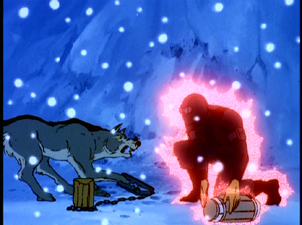
The animation on the show was somewhat consistent, and was actually a step-up when compared to The Transformers. The show is bright, colorful, and features a handful of relatively simple special effects. The key to the show are the human characters, which was a major flaw in the early Transformers episodes where characters’ voices many times did not match the facial expressions. Here, the characters feature a larger range of facial expressions that actually match the visual, much to the credit of the animation directors. My main issue with regards to the animation here is with the animated eyes. We only get to see Cobra Commander’s eyes, so when it is inconsistent from episode to episode, it gets to be annoying. In other frames, the different Joes consistently look cross-eyed. Of course, not everything has to be perfect, but the lack of quality control adds up so that even some title cards have misspelled words and typos. Due to the time lapse between different miniseries, some of the characters when through modified character designs, most notably Snake Eyes and Cobra Commander. This was due to redesigned toys that had appeared in the market between the first and second miniseries.
Scratch Tracks:
G.I. Joe comes with one basic English Dolby Digital 2.0 track. Despite the basic nature of the track, the overall quality is good. The show features its fair share of explosions and laser sounds (in place of actual fire arms). There are no subtitles or foreign languages included in the set.

Final Cut:
Fans of G.I. Joe that were disappointed with the Rhino releases from a few years back were probably thrilled to see the show getting a re-release on DVD. Hopefully, it will be successful enough to lead to the launch of the full second season of the show which has never been released on DVD (as of today, Shout has not announced season two). The show is classic 1980’s American animation. In hindsight, sure, it’s a bit ethnocentric and features very little diversity in its cast, but that has more to do with Hasbro’s toyline and less with the producers of the show. While the miniseries get very repetitive and there is only mild character development to be found in this set, there is hope as the series found its voice and the first season developed. Casual fans of the show may be put off by the running time and the price tag, but might be interesting in owning the miniseries that started the phenomenon. This set is really recommended for fans of the show who will appreciate the time and effort Shout! Factory has put into this set.
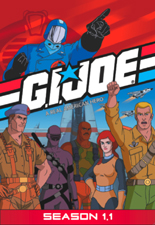 | ||
 |










